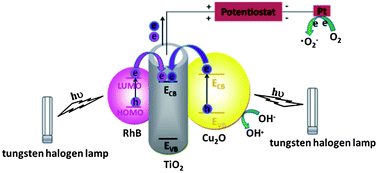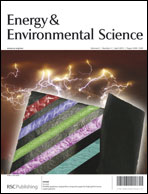p–n Heterojunction photoelectrodes composed of Cu2O-loaded TiO2 nanotube arrays with enhanced photoelectrochemical and photoelectrocatalytic activities†
Abstract
Cu2O/TiO2 p–n heterojunction photoelectrodes were prepared by depositing different amounts of p-type Cu2O nanoparticles on n-type TiO2 nanotube arrays (i.e., forming Cu2O/TiO2 composite nanotubes) via an ultrasonication-assisted sequential chemical bath deposition. The success of deposition of Cu2O nanoparticles was corroborated by structural and composition characterizations. The enhanced absorption in the visible light region was observed in Cu2O/TiO2 composite nanotubes. The largely improved separation of photogenerated electrons and holes was revealed by photocurrent measurements. Consequently, Cu2O/TiO2 heterojunction photoelectrodes exhibited a more effective photoconversion capability than TiO2 nanotubes alone in photoelectrochemical measurements. Furthermore, Cu2O/TiO2 composite photoelectrodes also possessed superior photoelectrocatalytic activity and stability in the degradation of Rhodamine B. Intriguingly, by selecting an appropriate bias potential, a synergistic effect between electricity and visible light irradiation can be achieved.


 Please wait while we load your content...
Please wait while we load your content...